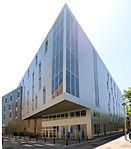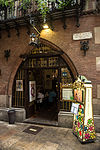Palau de la Música Catalana

Palau de la Música Catalana (Catalan pronunciation: [pəˈlaw ðə lə ˈmuzikə kətəˈlanə], English: Palace of Catalan Music) is a concert hall in Barcelona, Catalonia, Spain. Designed in the Catalan modernista style by the architect Lluís Domènech i Montaner, it was built between 1905 and 1908 for Orfeó Català, a choral society founded in 1891 that was a leading force in the Catalan cultural movement that came to be known as the Renaixença (Catalan Rebirth). It was inaugurated on 9 February 1908. The construction project was mainly financed by Orfeó Català, but important financial contributions also came from Barcelona's wealthy industrialists and bourgeoisie. The palace won the architect an award from the Barcelona City Council in 1909, given to the best building built during the previous year. Between 1982 and 1989, the building underwent extensive restoration, remodeling, and extension under the direction of architects Oscar Tusquets and Carles Díaz. In 1997, the palace de la Música Catalana was declared a UNESCO World Heritage Site along with Hospital de Sant Pau. Today, more than half a million people a year attend musical performances in the Palau that range from symphonic and chamber music to jazz and Cançó (Catalan song).
Excerpt from the Wikipedia article Palau de la Música Catalana (License: CC BY-SA 3.0, Authors, Images).Palau de la Música Catalana
Carrer del Palau de la Música, Barcelona
Geographical coordinates (GPS) Address Phone number Website External links Nearby Places Show on map
Geographical coordinates (GPS)
| Latitude | Longitude |
|---|---|
| N 41.3875 ° | E 2.1755555555556 ° |
Address
Palau de la Música Catalana
Carrer del Palau de la Música 4-6
08003 Barcelona (Ciutat Vella)
Catalonia, Spain
Open on Google Maps










